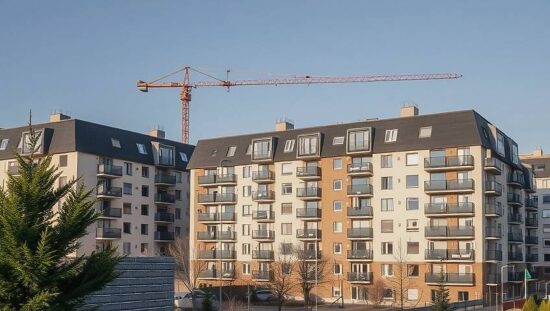In 2024, Germany approved the construction of 215,900 dwellings. According to the Federal Statistical Office (Destatis) on Tuesday, this represents a decrease of 16.8% or 43,700 dwellings compared to the previous year. This marks the third consecutive year of a decline in the number of approved dwellings, with the last such decline seen in 2010 (187,600 dwellings).
The number of approved dwellings includes those in new and existing buildings. The figure for approved dwellings is a crucial early indicator of future construction activity.
After a 26.6% decline in the number of approved dwellings in 2023 compared to the previous year, the decline slowed in the second half of 2024, with a 12.5% decrease compared to the same period in the previous year.
In 2024, a total of 172,100 new dwellings were approved, which is a 19.4% or 41,500 decline compared to the previous year.
Around 93% of the approvals for new dwellings in Germany in 2024 were for companies and private individuals. These two groups are the primary drivers of the overall development. In 2024, 92,300 approvals for dwellings were for companies, a 21.6% or 25,400 decline compared to the previous year. For private individuals, the number of approvals was 68,400, a 15.6% or 12,700 decline compared to the previous year. The number of approvals for dwellings on the public sector’s building applications decreased by 19.8% or 2,200 to 8,800.
Looking at the building types, the number of approvals for new dwellings in 2024 decreased more significantly for single-family homes (-20.3% or -9,600 on 37,900) than for two-family homes (-11.3% or -1,600 on 12,700 dwellings). These two building types are generally built by private individuals and make up around a third (29.4%) of the approved new dwellings in Germany in 2024. The number of approvals for single and two-family homes stabilized at a low level in the course of 2024, with a record low of 3,900 in January 2024.
Around two-thirds (66.4%) of the approved new dwellings in Germany in 2024 are in multi-family homes, with a 19.7% decline compared to the previous year (-28,000 on 114,200 dwellings).
Even the new building projects for non-residential buildings were lower in 2024 than in 2023. Non-residential buildings include, for example, factory buildings and storage halls, office and administrative buildings, or agricultural business buildings. The central indicator for measuring construction activity is the gross floor area. For the approved non-residential buildings, this decreased by 2.9% in 2024 compared to the previous year to 193 million cubic meters, the lowest level since 2014 (186.8 million cubic meters).
While the gross floor area for commercial buildings decreased by 17.5% in 2024 compared to the previous year, it increased by 3.4% for storage buildings and decreased by 7.7% for factory and workshop buildings and by 13.5% for office and administrative buildings.
The decline in the gross floor area for office and administrative buildings in 2024, at 13.5%, led to a new construction volume of 15.6 million cubic meters. From 2010 to 2021, the gross floor area for this building type had increased significantly, from 10.8 million to 27.3 million cubic meters. In 2022, a decline to 22.8 million cubic meters occurred, which continued in 2023 and 2024. The decline of 43.0% between the beginning of 2021 and the end of 2024 may be attributed to a reduced demand for new office and administrative buildings due to the increased working from home since the COVID-19 pandemic, according to the statisticians.





